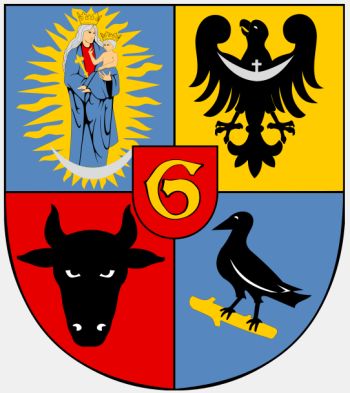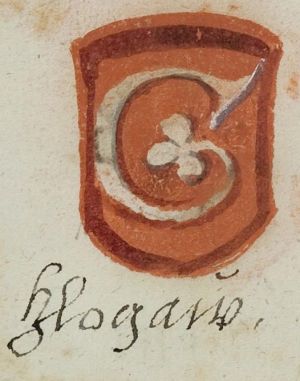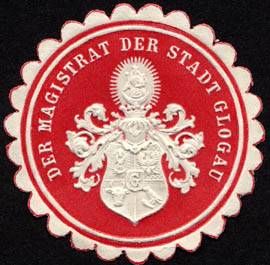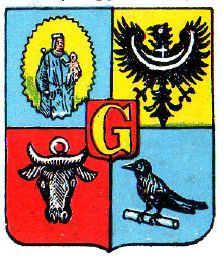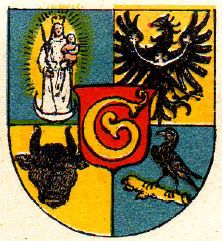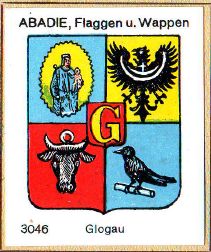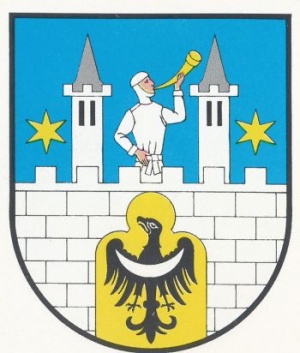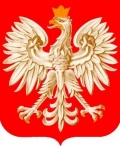Głogów
GŁOGÓW
Province: Dolny Śląsk
County: Głogów
| Polish | No blazon/translation known. Please click here to send your (heraldic !) blazon or translation |
| English | blazon wanted |
Origin/meaning
The oldest seal of Głogów (Glogau) is known from the 14th century (oldest known use from 1310) and shows a city wall with gate and two towers, with between the towers a hornblower and on the other side of the towers a star. In the gate the coat of arms of Silezea (black eagle with crescent and cross) is seen.
A second seal, known from 1326, shows in a field with stars the H. Mary with child, flanked by St. Nicholas on the one side and on the other side ten human heads. St. Nicholas was the patron saint at the time and the ten heads probably denoted the local city assembly. The seal thus meant that Mary blessed both the religious as the worldy powers in the city. A third seal is known from 1342 and again shows the Madonna on a throne flanked by a small shield with the eagle of Silezia. Several other 14th and 15th century seals all show the Madonna in different styles.
The first arms were granted on March 17, 1490 by Mathias Corvinus, King of Hungary. These arms showed a blue shield with a black raven standing on a silver branch. The shield was covered with a helmet with black and golden mantling and as a crest again the raven. This is the coat of arms of the Corvinius ('raven') dynasty.
In January 1504, the new ruler Duke Sigismund of Poland granted a new seal and coat of arms, that showed the H. Mary with child in front of a radiant light, which was based on the older seals of the city.
During the 16th and 17th century three different images were used on the seals; the eagle of Silezia, the older seal with the raven and a seal with the letter G for Głogów.
In the middle of the 18th century the complicated coat of arms with the different elements from the older seals; the first quarter shows the Madonna in a radiant light, the second the eagle of Silezia, the third a bull's head, the fourth the raven ans as an escutcheon the initial G. The large arms also showed a helmet, mantling and the raven as a crest. The meaning of the bull's head I do not know. During the years the colours of the different elements have changed, as can be seen from the images above and below.
After the second world war the city reverted to the oldest known image of the seals; the city wall with hornblower etc; to remove the religious and royal symbols in the arms. Only in the mid 1990s the old complex arms were restored.
| The arms in a 16th century manuscript |
Seal from around 1900 |
| The arms around 1900 |
The arms around 1900 |
| The arms in the Kaffee Hag albums +/- 1925 |
The arms in the Abadie albums |
| The arms as shown in 1963 |
The arms as shown in 1994 |
Poland heraldry portal
This page is part of the Poland heraldry portal |
Heraldry of the World |
|
Civic heraldry:
|
Other heraldry: |
Contact and Support
Partners:
Your logo here ?
Contact us
© since 1995, Heraldry of the World, Ralf Hartemink 
Index of the site
